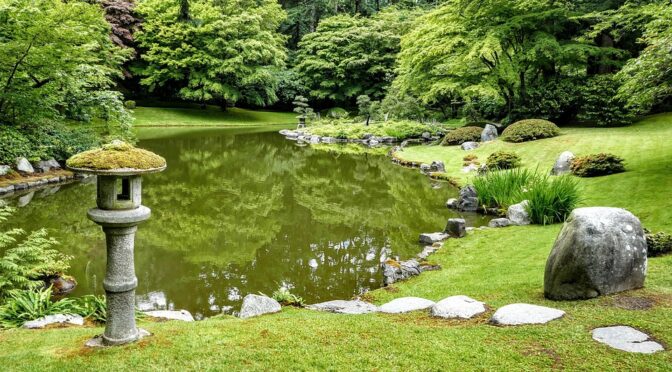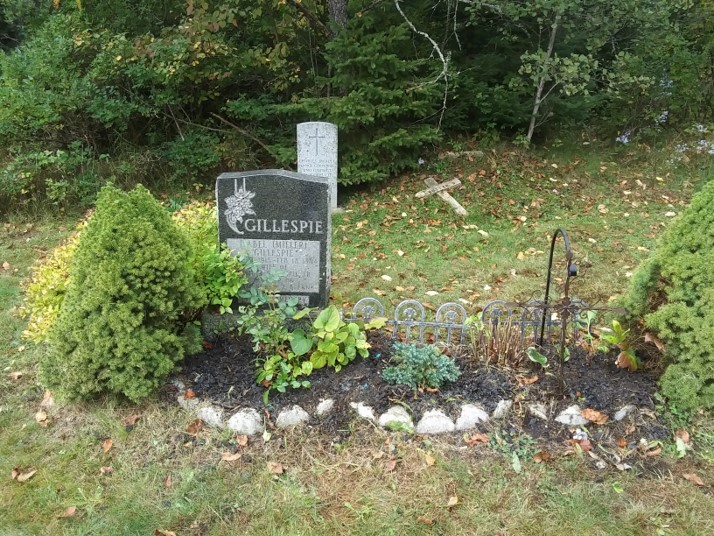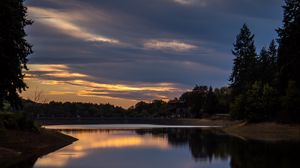I am very nostalgic about the past, especially relating to my childhood. Recently, I was discussing some of those happy memories and how the creation of a memory garden is so soothing and comforting. As a gardener, it is delightful to choose a quiet spot, and turn it into a special place to honour those who have meant a lot to me over the years.
I’ve done this before, when I owned the home farm in Wollaston Township, Hastings County, on the outskirts of the Village of Coe Hill. I wanted some trees planted along the fence across from the front yard, so encouraged an old man, Archie Hannah, who lived with us, to plant one he chose.
Archie was a pioneer, having been raised in an isolated farm miles away on the South Road. Gradually over the years he had moved to town and lived at the opposite end of the village as I was growing up. But he came to live next door, when my neighbour, Harold Crosby’s wife died.
I wanted to go to Toronto to take nurse’s training but needed someone to look after some livestock I owned. Turned out it was perfect timing, as Archie needed a new home. He became a Grampa I didn’t have, and was at my wedding, then later kept an eye on my toddler, a little girl who kept falling down as she learned how to walk. Sadly, Archie died in Bancroft Hospital, age 89 after suffering a stroke. But I have happy memories together, riding to many horsey events in his old half ton truck, with my Morgan gelding, Banner, in the back. Archie also raised pigs. In the photo, this is George, a purebred Yorkshire boar that we bought together so long ago.
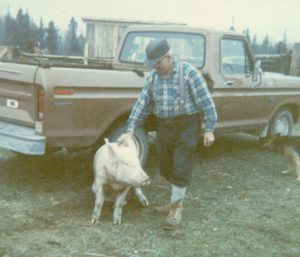
Archie had built some racks for that truck. Banner was used to standing in there, eating from a hay net tied inside, as he was. My last horse ride with him was in the fall before we moved to Alberta. My eight year old daughter sat on her pony, and I on my bigger horse, as we quietly rode along together enjoying a country road, then coming down the lane to the barn. I never knew we would never do this again. My girl is now an adult with her own daughter, and I have a tack box of my girl’s pony saddle and other tack, just waiting for munchin to enjoy, too.
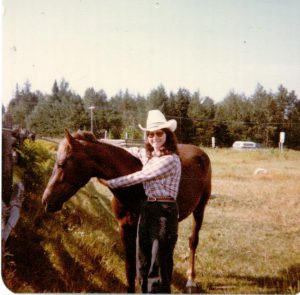
I cannot forget Harold Crosby, who lived across the road as I was growing up. He and his wife, Gladys, and their daughter, Nola, meant a lot to me. The mother taught me how to knit, as we sat together in their living room. Nola and I loved to open an old trunk in the attic and pull out some ancient dresses and hats. Down the stairs we would come, all decked out with long beads of jewelry, even adding a bit of lipstick, our first makeup, which I had to scrub off before going home.
I can remember learning to dance, as Harold showed me how to waltz around the room. Oh how we kids screamed in fun one Halloween when he wore a white sheet and chased us around outside. Naturally I would never tell anyone how scared I was at first at the shock of this ‘thing’ coming at us, with a banshie yell and wavy arms. Yes, Harold has a special tree in our farm’s front yard, that he planted himself. Wish I had added a little plaque on a chain with a name on it, one for each person’s tree that they planted. I am the only one that can still identify the trees and the planter.
I passed by the Coe Hill farm not long ago, some 65 or so years after these events, and was so happy to see those special trees still there. Both men are long dead. But the memories are as fresh as when they first happened.
My last memory garden is a tiny spot between my grave plot and Mom’s tombstone in the Coe Hill Anglican Cemetery. I just added a fragrant, pink shrub rose for her, Mom’s favourite colour, and some more bulbs, which will bloom every spring, long after I am gone. I love their yellow/blue combination. I discovered a black mulch made out of rubber this spring, and spread it thickly, hoping it would last a long time. There is no one to care for my special place, so each visit get more meaningful now. I’ve made a few mistakes, like not using Dwarf Alberta Spruce. Even a simple spirea bush I carefully pruned can grow into a large sized plant.
I needed help this time with planting things and scrubbing Mom’s stone to remove the algae growing on it this spring. Not too happy with the wreath this year, but it, too will soon be gone. and who really cares but me. I do care, a lot. So make your special place the way YOU want it. These tips just give you ideas and alerts from the mistakes I have made.
What about a plaque? Could be a simple sign hanging by a chain around a tree. Something more long lasting might be one prepared by a tombstone company. As a genealogist, it is important to me for future visitors, that the basics of a person’s life be preserved, like full name, and dates for birth, marriage and death, and names of children. Maybe you can provide a hint as to the person’s interests in the sign design, just as one does on a tombstone.
Now for more serious gardening tips I have learned over the years. Begin with the location, and pay attention to the soil and moisture–the key things that makes or breaks success in any gardening project. You need sprinkler lines and electrical power lines in tubes installed before planting an area, especially if you want sockets for outdoor lighting to the garden, or to run a pond pump. If you forget, there are soaker hoses that can be laid on top, partly hidden by the vegetation, but do you have source of pressure water to use with them? What if there is no water source at all? Add a lot of compost to help hold moisture in the soil, if it is naturally sandy. There is a wide range of soils across Ontario, and across North America. Your local Agricultural Representative can help you identify your soil type and ways to improve it.
May I suggest you do a plan on paper first, and study it carefully to rule out problems before they become permanent. You can do it on graph paper, or buy a computer program for gardening that lets you design the whole thing and see it in its full dimension on the screen. That program lets you shift things, choose the plants and see if you like their placing, and even add accessories, like benches, music speakers, even statues, if you like them as I do.
I tend to get excited, wanting to get started, so never did this for the cemetery, but used it when planning a garden for others. Some of us are just more fussy about details than others, and I am a list maker. These are just hints that I found helpful. Studying the layout may mean looking at below ground factors like: where is it safe to dig, and should I call in the hydro to check all lines coming into the property?
The other factors are of course above ground, like the movement of the sun and wind over the area. Know your Agriculture Zone, so when you choose plants for the ground, you will know which ones are hardy for your area. I loved the gardens at Disney World in Florida, but none of those plants would survive here. Zones refers to temperatures for different locations in the layers of coldness at maximum temperature. It is coldest at the North Pole, and gets warmer as one moves south. The zones indicate that. The Coe Hill farm in Ontario, Canada is in Zone 5, on the border with Zone 4, and has a nice range of plants for that region.
I have lost plants from winter kill because it takes time to understand annuals, bi-annuals and perennials, and their growth. I like growing new plants each year. You may have more than one Zone in your garden around the house. Areas close to the house may be warmer than those further away, where the air currents can hit them. So if a plant is struggling in one area, try a new location, one slightly different and warmer. Now why didn’t I think of this sooner? Of course you can add a greenhouse to protect everything but for most of us, our memory place will be simple, relaxing, and peaceful.
Plants that prefer the shade may wilt a bit when the sun beams down on them all day. Tuck a few trilliums in a shady area to bring nature into your garden. They will spread gradually. Add lots of other woodsy plants, such as ferns, and bulbs of various kinds. The sun lovers won’t appreciate being hidden away in dimmer areas. Even shade has various depths, and I am amazed at the resilience of many plants who beam at us from less perfect conditions.
So like life, taking our circumstances and not letting them dictate our attitude, our mood. One of the most moving books I have read in the memory garden (don’t forget a bench or chair), is a very old one, Hinds Feet In High Places, which is an allegory about a scared individual travelling to the mountains to be healed. The person passes through the Misty Flats, and later shelters from a storm in a cave. The wanderer feels so alone and forgotten, but sees a tiny flower in the darkness of the cave. The flower said its name is: Acceptance With Joy.
There can be beauty from the ashes in our life. Not all of life is success, as we learn far more from our failures. Wood ash contains fertilizer, produced by the furnace’s heat. All plants need fertilizer, as their roots deplete the soil each season. What about us? No one reaches the end without having gone through some tough times. Let’s put down deep roots, hold steady and calm, and smile at the world in thanksgiving for life itself, the beauty around us, and most of all for the Maker, who is revealed in it all.
Listen and feel the wind, its direction and strength, which needs to be filtered for your chosen spot. Trees will do that, especially evergreen ones. Shrubs can be added for their colour leaves and beautiful flowers. I happen to love colour themes in the garden, like purple leaves on Smoke Tree shrub, Ninebark or the smaller ones, which I set in a long triangle across the yard to draw the attention of one’s eye.
A winding path is delightful to some of us, but too slow for others and how you design it helps set that mood. Some want a vista in the distance, while I like a closed- in, private feel to the site. Privacy helps me relax, and think, and shuts out a noisy world.
Seasons area important to remember, because you will want a variety of shrubs and plants that flower at different times over the summer. The yellow stems of Forsythia announce Spring in late April. 
Heavily scented Lilacs in deep purple or white open in May; Bridlewreath Spirea, with long shoots of white, arch towards the ground in June.
The big blossoms of Hydrangeas begin in July and extend into August, with many varieties adding colour and texture.
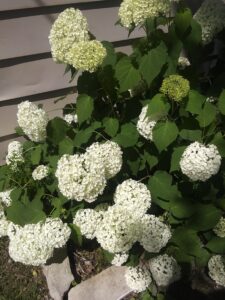
I love the tall grasses that leap over my head by fall. They also move in the breeze, swaying back and forth on a windy day.
Scatter shrubs a bit, rather than planting in straight rows. I’ve seen a marvellous berm used to create levels of greenery. A berm is a pile of good soil of some substance, both in depth and length and height. I once designed one for a friend in Nevada and added a dry rock waterbed and curved the river out of sight.
Make it real, if you want, but think of winter and how you will drain water without damaging the line. A pond is delightful, but if you include fish, be prepared for the visit by coons and herons, and even creatures one does not want. You can add some narrow tunnels in which fish can hide, install water plants which bloom and cover the surface. A netting just below the waterline in the pond helps protect those living below. I love the gentle sound of moving water, especially as it cascades over rocks and edges in the planting. Feel the moisture in the air after a rainy day or the drifting spray of the waterfall.
Any structure, be it a solid fence, or band of trees, will affect a current as the wind arrives. It hits the wall, lifts to go up and over, then comes crashing down hard on the other side, all based on the height of that resistance. So, give some thought how to soften that current, or redirect it. Slats between fence boards do that, as an example.
Remember the five senses when designing and creating your Memory Garden. A lovely fragrance is important to me, especially with roses. It also means you won’t find skunk cabbage in my garden Colour affects mood. Hospitals and medical settings use colour on walls to calm people. So pinks, silver, blues and greens are quieting, Dominant reds and strong yellows and oranges stimulate. They are fine around a tennis court, and often are in the back yard where the kids play. Keep the quieter colours in the entrance way, and where you prefer to sit and relax.
Sight, and how to control where the eye goes in the garden, is affected by a lot of things, some already mentioned. One can guide a person around a garden through creating openings and then blocking other areas. Each garden room can be different than an earlier one, but the transition between them can also change, or remain the same as a unifying link. Develop mystery in a garden this way, and give a reward at the end of a path, such a sit down place to see something beautiful. Imagine discovering the Memory Garden after a casual walk. A bench along the path can be your memory garden, or an outdoor room by itself, or just a stop somewhere where you like to rest, like a patio chair.
The Memory Garden will probably be an outdoor room, but it can be several with perhaps a sitting area in the far corner, with a pond at another end with its little water fall. You don’t want to sit too close to moving water unless there is bathroom nearby. Just the reality of life for the gardener.
Do you want a hedge around it, which can be any height to create a boundary? I love yew hedges, but there is a danger from its seeds, which are poisonous, as are some other common plants. Keep them out of your memory garden in case a child visits. An old shed makes a lovely garden addition. At a garden show one creator had people walk through the simple shed to get to a special little garden. Hide mirrors in certain spots to deepen the look of a small space.
You can hide an area with grasses, or create a very formal look with perfectly lined up plants in a bed in rows of a single colour. Or the typical English garden with its mosaic of garden perennials in multiple colours. Each person will have their own sense of what they like, but may not know how to create that look. Hire a garden professional to help you with that, or simply study or explore in your own gardening work.
What will happen to your special spot when you are gone and no one in the family wants to care for it? Plan for that, if you can. All trees, all plants have a lifespan, just as we do. So consider that also as you plan and work on your Memory Garden. It really is for you and your memories, to have a place of peace, tranquility and safety. Should you fence the area, to keep out livestock or rodents, or will you welcome some of them, like little bunnies, who hop by?
It takes time for nature to take over your spot dusting it with falling leaves. Find a gardener to take over your garden when you are gone, if you can. This will help prolong the memories we want to preserve. We see this in cemeteries around the countryside. Forget any negatives, just embrace this moment, and the pleasure it brings you. Welcome the birds and butterflies into your garden maybe feeding them, and think of their long journey spring in fall…..they need a rest, too.
I find that too many blended colours upset me a bit, as they jar rather than soothe. So I prefer a quiet, soft palette with not many colours in one place. I also look at gardening books and videos in my collection, such as Butchart Gardens on Vancouver Island. A gorgeous, public garden build out of rock quarry. I learned a lot during my visit years ago, and other landscapes in passing.
What other things bring you peace, satisfaction, enjoyment? My six year old granddaughter collects rocks from the places she visits, and then paints them at home. I gather fridge magnets from my travels. What do you have that will remind others of you in your Memory Garden? You are also important, and what you create will reflect your interests, as well as those you are remembering.
In my travels, I have been delighted to find a little book case at the edge of a street or park, where someone puts in a few volumes for passing travellers. No charge; help yourself, or leave one in return.
What things can we offer others from our Memory Garden? Apples from a tree: grapes from a vine; fruit from a bush or a bouquet of flowers for someone who need a lift? Maybe a stop at a garden shed with gift items to sell, books that one writes, all passing through the Memory Garden to slow the person down, and introduce a quiet, tranquil place. ‘Smell the roses, sit in an old swing and watch the antics of a chickadee at the water fall.
What a special place for the favourite things of the person you loved, Should one consider sprinkling the ashes of that person in this Memory Garden, instead of at a local cemetery? Their simple plaque may be all that is left of the person after you are gone. What about a sign in the garden pointing to the places you loved, or indicating the movement you want people to take through your garden?

I used to think about adding a foot path of stepping stones engraved with the names of Gillespies of the past, or even a pet garden to remember our four-legged friends. People could buy a stone to have it engraved, or a tree with a name plate, to extend the memory of someone they cared about. Not every person has land in which to do this themselves.
We help each other remember the past, while making a bit of history ourselves in the meantime.
![]()
